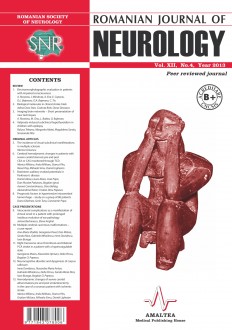SELECT ISSUE

Indexed

| |

|
|
|
| |
|
|
|

|
|
|
|
|
|
| |
|
|
HIGHLIGHTS
National Awards “Science and Research”
NEW! RJN has announced the annually National Award for "Science and Research" for the best scientific articles published throughout the year in the official journal.
Read the Recommendations for the Conduct, Reporting, Editing, and Publication of Scholarly work in Medical Journals.
The published medical research literature is a global public good. Medical journal editors have a social responsibility to promote global health by publishing, whenever possible, research that furthers health worldwide.
PROGNOSTIC FACTORS IN HYPERTENSIVE INTRACEREBRAL HEMORRHAGE – STUDY ON A GROUP OF 80 PATIENTS
Dana Ghelmez, Sorin Tuta and Constantin Popa
ABSTRACT
Introduction. Hypertensive cerebral hemorrhage remains a severe disease with ahigh mortality. Current therapeutic options (including surgery) are limited, therefore prognostic elements are important in selecting patients for the testing of more aggressive future therapies. Prognosis depends on the location of the lesion (supratentorial versus infratentorial), size of hematoma, state of the patient at admission (measured by GCS scale), patient age and associated comorbidities.
Objective and method. Clinical and imaging correlations of various vital prognostic factors for ICH were evaluated (Glasgow Coma Scale, volume of hemorrhage, presence and volume of ventricular blood, location of bleeding, patient age). The hypothesis of integration of all these prognostic factors was tested and external validation of the ICH prognostic scores was tried. ICH score is one of the predictors for mortality at 30 days due to cerebral hemorrhage. We analyzed 80 patients with cerebral hemorrhage admitted to the National Institute of Neurology and Neurovascular Diseases Bucharest and we evaluated the independent prognostic factors above, but also integrated them into the ICH score which we correlated with the death rate.
Results and conclusions. The deaths rate in the study group was 39%. The presence of intraventricular blood was associated with a higher death rate and this rate was directly proportional to the amount of intraventricular blood. ICH score was externally validated in this cohort study as a reliable prognostic method, relatively easy to use and accurate for vital risk assessment in patients with cerebral hemorrhage.
Keywords: ICH score, intracerebral hemorrhage
